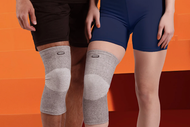Most compression sleeves or garments may be too tight to sleep with for long periods. However, recovery or non-compression sleeves, provide a lower compression lev...
Most compression sleeves or garments may be too tight to sleep with for long periods. However, recovery or non-compression sleeves, provide a lower compression level and more mobility, making them suitable for sleeping.
If you want to know whether you can sleep with recovery sleeves, check out the benefits of it and determine whether it’s a good solution for you.
Let’s get started!
Is Sleeping With Recovery Sleeves Good or Bad?
Recovery or non-compression sleeves are generally ideal for sleeping, as they’re designed to help during extended recovery periods.

Unlike regular compression garments, non-compression sleeves use a breathable, flexible, and durable fabric with semiconductor elements. This helps muscles and joints recover from pain or injury and move freely.
Since there isn’t pressure, it doesn’t restrict blood flow, making it safe to wear while sleeping.
These qualities also make it suitable for all-day use.
Can I Wear Compression Garments to Sleep?
Most experts don’t recommend wearing compression stockings to bed because they might restrict circulation. This can occur if they are too tight leading to serious complications or further injury such as blood clots or vein disease.
We don’t recommend wearing compression socks to bed since compression garments are designed to provide benefits while moving. This includes when working out to improve athletic performance.
On the contrary, non-compression sleeves are designed for rest, recovery, and light exercise. If you must wear compression socks or sleeves to bed, only wear them for naps. Be sure to notify your healthcare professional to ensure it is safe for you.
The Benefits of Sleeping With Non-Compression Sleeves
Non-compression socks work by improving circulation to help you recover. Check out the benefits of using non-compression sleeves below.
Helps With Recovery
Most doctors recommend wearing non-compression sleeves to those who have had surgery, an injury, or experienced joint or muscle-related pain, such as arthritis.
These sleeves use advanced fabric, like Thermo’s nano bamboo charcoal fiber, to increase blood flow and reduce swelling. Overall, they aid the body’s natural healing process.
Relieves Pain
Non-compression garments help relieve pain over some time.
A pilot study compared the effectiveness of compression stockings and non-compression sleeves after total knee arthroplasty. Researchers found that non-compression sleeves help relieve pain after three weeks.
These sleeves also reduce swelling and improve range of motion better than compression stockings.
Regulates Temperature
Non-compression sleeves include heating elements that add warmth and help maintain a comfortable temperature, especially while sleeping.

For example, Thermo’s embedded bamboo charcoal fiber releases infrared waves that cause cellular vibrations. These vibrations can help to increase blood flow, oxygen, and nutrient circulation ultimately improving healing.
Provides Comfort and Mobility.
The non-compression sleeves have a breathable and flexible fabric making it easy to move around. Additionally, being non-compressive provides less restriction of the blood vessels leading to improved circulation and blood flow.
As a result, they’re safe to wear for long periods, like sleeping or during a long flight.
Frequently Asked Questions
Here are some of the frequently asked questions.
How Long Should You Wear Non-Compression Garments?
You can wear non-compression stockings, socks, sleeves, and other garments several hours a day or for long periods. Be sure to change them regularly to avoid skin irritation.
For best results, consult your manufacturer’s recommendations or your primary care provider for safety.
When Should You Take Off Non-Compression Garments?
Remove your non-compression sleeves before bathing or when tending to a wound. This will help to prevent skin irritation.
They are safe to wear when falling asleep or while doing everyday activities.
What Are the Kinds of Non-Compression Garments You Can Wear While Sleeping?
You can find various non-compression garments from the upper body to the lower legs. These include shoulder, elbow, wrist, back, knee, and ankle sleeves.
Should You Use Non-Compression Sleeves to Sleep?
It’s important to know that you can sleep with recovery sleeves and we highly recommend it. They improve blood flow and don’t restrict your movements leading to a good night’s sleep.
Ultimately, it’s best to consult your healthcare provider if you should wear one for your condition.
If you want to naturally aid your recovery, check out the different Thermo products available in our shop. Our recovery wear suits people who experience chronic muscular and joint pain or discomfort.






